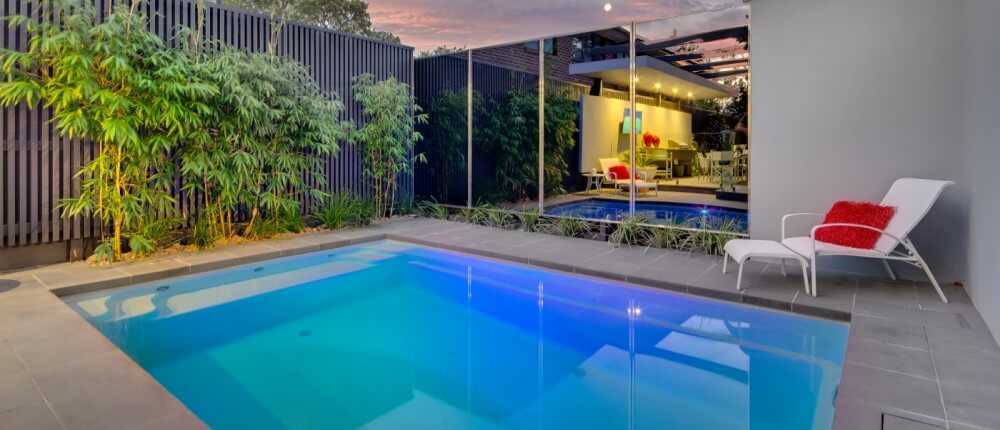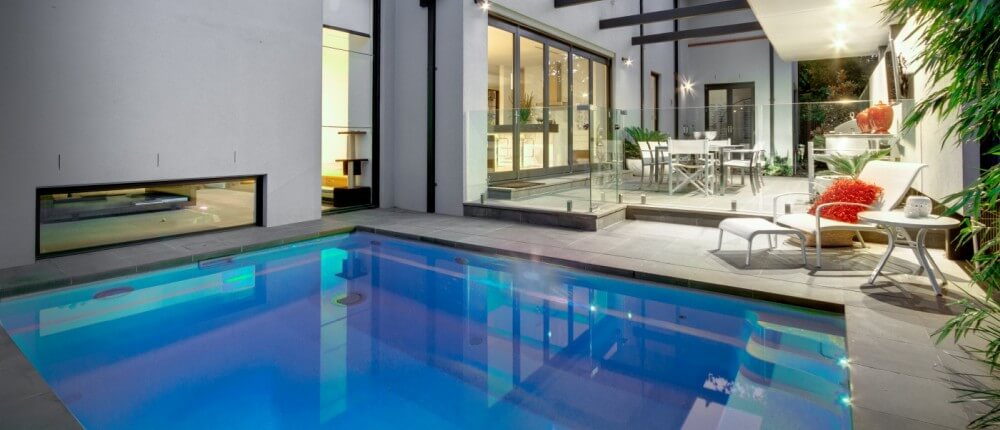The popularity of Australian plunge pools has grown hugely in recent years, with more and more homeowners choosing to install plunge pools in their backyards. So if you have not yet heard about this trend, or you are considering buying a plunge pool of your own, it’s time to find out all about them.
We have taken a detailed look at the plunge pool in order to bring you all the information you need to decide whether this could be the right swimming pool choice for you for 2026 and beyond.
What is a plunge pool?
A plunge pool is a small pool which is defined by a number of characteristics:
- Usually between 2 and 6 metres long, although it can be up to 7 meters in length
- Between 2 and 3.5 metres wide
- Often no deeper than 1.2 metres, although this varies greatly
- Contains large, comfortable seating areas for relaxation
As you can tell from these characteristics, plunge pools are primarily designed for relaxation rather than swimming, but there are ways around this. Many plunge pools come with the option of swim jets. These add resistance to the water, enabling you to swim in one spot in a small stretch of water for as long as you like. This gives you a workout as intense as if you had been swimming laps in a much larger pool, although swim jets do feel a little different to swimming in water with a natural current.
You can also improve the relaxation experience in a plunge pool by transforming it into a spa. Adding spa jets helps to soothe tired muscles and relieve stress and anxiety, enabling you to unwind more easily and get the maximum benefits from your plunge pool. However, spa jets, like swim jets, are optional extras, and a basic plunge pool will not come with them as standard.
Why are Australian plunge pools so popular?
Plunge pools offer a number of benefits over larger swimming pools. The small plunge pool size is ideal for those homeowners who have a small backyard, but still want the benefit of owning a pool. This makes plunge pools particularly popular in highly populated urban areas where backyards tend to be small.
Installing a plunge pool makes a small backyard look more attractive, and makes your whole property appear more luxurious. It is not only a highly convenient leisure facility, but it can also be a standout design feature which gives your backyard an instant visual appeal. Plunge pool designs are now extremely varied, so it is relatively easy to find a design which suits your style as well as your usage needs, and it can be made even more attractive with the right landscaping and lighting. This can be enough to give your entire property the “wow” factor.
Plunge pools are also better for the environment than larger pools, as they use less water and require smaller amounts of chemicals to keep clean. They also use less energy as they are cheaper to heat and need less powerful filtration systems, so they are popular with anyone interested in sustainability and reducing their carbon footprint, as well as those looking to lower their energy bills.
In addition, the small plunge pool size makes them easier to clean and maintain, leaving you with more free time to spend enjoying your pool instead of cleaning it. There are even plunge pools with self-cleaning options available, such as the Vantage in-floor cleaning system from Compass Pools, which you can simply switch on and it will clean your pool for you. This means your plunge pool will always look pristine, keeping your property looking well-maintained, and saving you the time-consuming job of cleaning your pool.
Of course, the popularity of plunge pools also has a lot to do with the benefits they have for health and wellbeing. A plunge pool is ideal for cooling down in summer, but it also provides you with the perfect place to relax at the end of a stressful day, turning your backyard into a calm and peaceful haven where you can de-stress in the soothing water. Plunge pools make this important benefit available for almost everyone, not just those who have the luxury of a large backyard.
What are plunge pools made from?
Like regular swimming pools, most plunge pools are made from either concrete or fibreglass. Both of these are extremely strong, durable materials which can withstand even extreme weather conditions and natural events such as earthquakes, so a concrete or fibreglass plunge pool is built to last a lifetime.
The main difference between the two is that concrete plunge pools are designed especially for your property, so each one is unique and has to built onsite. This is a complex and lengthy process which can take several weeks.
Fibreglass plunge pools, on the other hand, are premade in a range of standard shapes and sizes for you to choose from. Your chosen pool shell is then delivered to your home by road, and installed in your backyard. While this is still a significant building job, it is a quicker process than installing a concrete plunge pool, so it is likely to take days rather than weeks.
There are DIY pools available at lower costs, but these are usually made of vinyl-liner. This is a much weaker material which is very susceptible to wear and tear, so the lining often needs repairing and will have to be replaced completely every few years.
What does the plunge pool installation process involve?
Installing a plunge pool is much the same as installing a larger swimming pool; the process depends on how you want your pool installed. Inground plunge pools are probably the most popular and tend to look the most professional, as these are built into the ground of your backyard. The area around the pool is then tiled, so you have a pool and a space around it for relaxing and entertaining, all as part of a cohesive design for your property.
However, some homeowners choose to have an above ground plunge pool, as this can be done more quickly and easily, and at a far lower cost. An above ground plunge pool sits on top of the ground, so no excavation is required and the process can be completed in a matter of hours, so you can use your plunge pool almost straight away.
There are some homeowners who choose to install their DIY plunge pools themselves, but this is not recommended. There is too much risk of something going wrong, which can be extremely costly and even dangerous, so this is a job which should be left to an experienced professional pool builder.
What does a plunge pool cost?
Plunge pool costs depend on a number of factors, including:
- The brand of the pool
- The build quality
- Whether you want your pool installed inground or above ground
- The features you choose to include
For a small plunge pool installed inground, you can expect to pay in the region of $25,000, but if you want a top quality model in one of the largest sizes, this can increase to $35,000 or even $50,000. The installation process is no different from installing a full-sized swimming pool, so the costs are quite similar.
If you choose an above ground plunge pool, you can save a lot of money, as on average these cost from $2,000 to around $7,000. Of course, it is possible to purchase DIY plunge pools for even less, but this is often a false economy due to the level of maintenance they need, and the possibility of errors during the installation process.
You also need to remember that every pool, even a small plunge pool, has to be surrounded by fencing in accordance with Australian Standard 1926, so you need to factor this cost into your budget.
Any pool, including a plunge pool, is a significant investment, but the benefits of owning a plunge pool are numerous. It is an asset which you can continue to enjoy for a long time into the future, improving your quality of life and making your property even more beautiful.
Contact us for more plunge pool ideas
If you are interested in owning a plunge pool and would like more information, please contact us. We can supply and install the full range of Compass Pools fibreglass pools, including plunge pools, with the option of all the features exclusive to Compass Pools, such as Bi-Luminite colours and the Vantage in-floor self-cleaning system.
With two different plunge pool designs to choose from, in a range of sizes, our specialist team can help you find the ideal plunge pool for your property, and make the installation process run quickly and smoothly, leaving you free to enjoy your stunning new plunge pool to the full.




